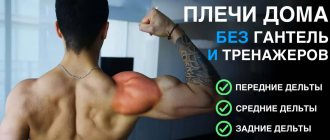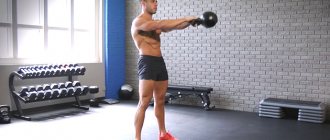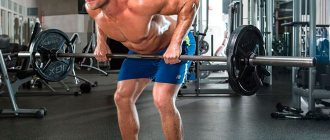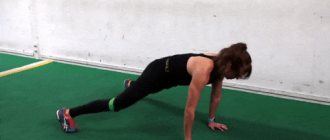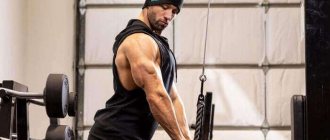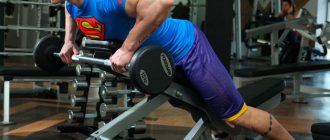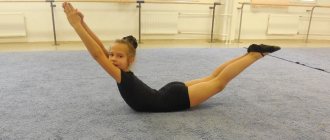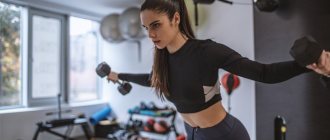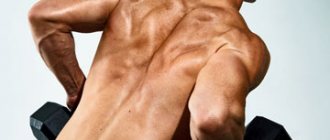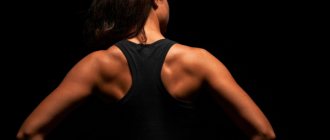What is axial load on the spine?
“ Axial load is the one at which vertical pressure occurs on the spinal column, that is, on the axis of the body,” explains Stepan Proshin, trainer at the Fitness Studio 29 personal training studio . “It is given by exercises in which the weight of an apparatus (barbell, dumbbells) presses on the vertebrae from above.” But not only that: we encounter axial load on the spine every day - for example, while walking. “The constant and significant axial load on the spine, which exerts vertical pressure on the intervertebral discs, is a consequence of our evolution, the price to pay for walking upright,” says Irina Galperina, yoga therapy teacher at the Yoga-Mind studio school .
— Our body is constantly under the influence of gravity (gravity), which leads to certain problems of the spine. Osteochondrosis (primary degenerative process) is to some extent the result of gravity. Osteochondrosis entails a number of other not very pleasant changes in the spine: protrusions, hernias, spondylosis.” But what really harms the spine is intense axial load - for example, when performing exercises with dumbbells from a standing or bending position. “For healthy people, it is dangerous due to back injuries if the technique is incorrect and the training program is not properly structured,” says Stepan Proshin. “And in case of back diseases (hernia, protrusion, kyphosis, etc.), doctors advise excluding such exercises so as not to aggravate the existing problems.”
But all this does not mean that if you have a sore back, you need to give up fitness. “If axial load , it is important to avoid it in training and strengthen the back muscles to support the vertebrae and relieve pain,” says Tatyana Basyrova , candidate of athletics, graduate of the School of Russian Ballet, certified teacher of Pilates, Cycle and fitness yoga, personal trainer of the MyFitlab fitness club network . “In practice, this means eliminating squats with a barbell, dumbbells, deadlifts with heavy weights and choosing exercises that do not put stress on the spine - from a sitting position, on all fours or lying down.”
Classification of diseases of the spinal column
Unfortunately, statistics show that the percentage of people with back problems is growing every year. Currently, 85% of the world's population suffers from some kind of disease related to the spine. If you think that, for example, lower back pain only occurs in old age, then our center will hasten to dispel this stereotype: half of the people included in these statistics are under 35 years old. Below is a list of the most common spinal diseases:
- arthritis, or chronic inflammation of the joints;
- spinal disc protrusion;
- osteochondrosis;
- radiculitis;
- osteoporosis;
- scoliosis.
Of course, we should not forget about intervertebral hernias and various tumors, but the above diseases are the most common. Having identified the problem, the patient needs to begin treatment of the spine as soon as possible. As a rule, the doctor prescribes special medications suitable for your individual case, a course of therapeutic massage, attention to correct posture and physical exercise. The last point is very important to discuss in detail so as not to overdo it and cause harm. Maintaining a regimen is often the hardest for athletes, because the habit of constant heavy loads and literally continuous physical activity does not allow them to take care of themselves and their health.
Which exercises without axial load to choose?
There are not so few of them. “Axial load occurs in exercises while standing and with a strong inclination of the body when using weights. Accordingly, everything that is not connected with this can be considered exercises without stress on the spine,” adds Tatyana Basyrova.
Exercises in exercise machines also reduce the load on your back (especially if you work in a sitting position). If you are looking for weight loss exercises for a bad back , pay attention to strength movements while sitting, lying down or standing without weights. “The use of expanders may be a way out of the situation: they are not associated with an axial load on the spine, but at the same time increase the load on the muscles,” notes Tatyana Basyrova. Yoga is also useful for healing your back and strengthening the muscles of the whole body. “If you are a beginner, if you are not young, or you are simply tired, you can perform asanas lying down or sitting, with supports, gradually moving on to more demanding ones (physically and energetically), if you are young and full of strength, your start is standing poses. The main thing is to create a conscious-volitional effort to stretch,” adds Irina Galperina.
If you are a fitness fan and want to lose weight, pay attention to a set of exercises without axial load on the spine, compiled by Tatyana Basyrova. “All the exercises presented eliminate axial load, protect the spine, strengthen the muscles of the buttocks and legs - these are “helpers” of the spine and lower back. Thus, we completely strengthen the muscle corset, including the back muscles,” says Tatyana Basyrova.
How to build a lesson
- Start your workout with a light warm-up .
- Do the exercises consistently.
- Perform exercises in 3-4 sets of 20 repetitions each.
- Do this program 2-3 times a week.
- Finish your workout with stretching .
To perform the complex you will need a mat, an expander ring and dumbbells.
Implementation principles
No matter how severe the injury to the knee joint, gymnastic training will always be beneficial for the patient. Physical therapy is not able to cure the affected joint, but it can improve its function, as well as stabilize blood flow and activate muscle tone before surgery. There are two sets of knee exercises.
Of these, 1 part of the training is intended to facilitate movements and relieve pain during conservative treatment. It also serves as an excellent help in preparing the patient for various operations, especially endoprosthetics. And part 2 of the training complex is used for rehabilitation after traumatic ligament damage, as well as to speed up walking in the postoperative period.
Exercises for leg muscles
Raising the pelvis and spreading the legs
10 Lifting the pelvis and spreading the legs
Place the resistance band on your hips. Lie on your back, extend your arms along your body, bend your knees and place your feet on the floor. Leaning on your arms, shoulder blades, back of your head and feet, smoothly lift your pelvis above the floor and spread your hips, stretching the expander to the sides. Then return to the starting position. This is one repetition, complete the required number of repetitions.
Squats with an expander
1 Squats with an expander
Place an expander ring on your hips. Stand straight, feet shoulder-width apart, work your abdominal muscles, and stretch your head up. Join your palms into a lock. Bend your knees and push your pelvis back, lowering into a squat. Lean your body forward slightly, stretch your arms in front of you. Then smoothly return to the starting position and repeat.
Lunge Squat
Stand up straight, clasp your hands in front of you. Step your left foot back, bend your knees, and lower into a lunge. Then straighten your knees slightly and lower yourself back into a lunge. Straighten your knees, lift yourself up and place your left toe next to your right foot. This will amount to one repetition, perform the required number of such repetitions in each direction.
How can you sit unnecessarily?
The correct position of the back means adopting a posture in which the lower back is as relaxed as possible and relieved of heavy loads. Here are some rules to follow.
- Avoid chairs and armchairs with straight designs . If you work sitting and spend a lot of time at a desk, give preference to furniture with an ergonomic backrest. It should be identical to the physiological curves of the spine.
- If you do not have the opportunity to purchase a chair with an orthopedic back, buy a special bolster and place it under your lower back. Before purchasing, it is advisable to conduct several experiments and understand approximately what shape and thickness of the roller will suit you. To do this, at the initial stage, instead of a roller, you can use an ordinary towel folded several times.
- Adjust the height of the table or choose a new table to suit your height. Your forearms should not hang in the air, but lie on the surface of the table or rest against a special stand or chair armrests.
- Also take care to adjust the height of the chair . The correct position of the legs should be as follows: the thighs are parallel and the shins are perpendicular to the floor. If an armchair or stool is too high for you, purchase an adjustable footrest or use things like reams of office paper instead.
- If you have to sit on a chair for a long time, then doctors recommend doing a warm-up at least once an hour . In this case, it is not necessary to do any special exercises; it will be enough to simply change the position of the body. You can go pour some tea, wash the dishes, do pull-ups, walk to the store, or walk around the room a little.
- For activities related to writing, drawing or sketching, it is advisable to use a table with an inclined surface towards the person sitting. These are the desks that modern schools and kindergartens now offer their students.
- When sitting at the table, do not lean forward too much . The permissible tilt angle is 2 degrees. Otherwise, you will multiply the load on your spine and by the end of the working day you will feel severe fatigue (or even pain) in your back.
- If you feel pain or discomfort in your back, immediately change your position . In general, remember that changing your position frequently is one of the main keys to a healthy back. Try changing your body position several times during the working day. For example, work 2 hours while sitting, 2 hours while standing, and 2 hours while lying on the couch. If you frequently change your body position, then there will be no such thing as “wrong position” for you at all.
Chest exercises
Push-ups with wide arms
4 Push-ups with wide arms
Get down on your knees, place your palms wider than the mat and take a position lying on your straight arms. Lean on your palms and toes, stretch your crown forward and your heels back. Work your abdominal muscles, arms, back and legs. Maintain a natural curve in your lower back. Bend your elbows and lower your body down. Then smoothly return to the starting position and repeat.
Narrow push-ups
5 Push-ups with narrow arms
Get down on your knees, place your palms narrower than the mat and take an emphasis lying on straight arms. Lean on your palms and toes, stretch your crown forward and your heels back. Work your abdominal muscles, arms, back and legs. Maintain a natural curve in your lower back. Bend your elbows and lower your body down. Try to press your elbows to your body. Then smoothly return to the starting position, straightening your elbows, and repeat.
After a knee fracture
When a fracture occurs, not only the bones are damaged, but also the ligaments. After an injury, it is necessary to remain at rest, fixing the limb in a motionless state. Once the injury has healed, you can move on to exercise.
What to do:
- Before surgery, you may be able to move your toes to exercise this muscle group.
- After surgery due to a fracture, it is allowed to perform exercises in bed on the first day. You should not put any weight on your leg or exercise through severe pain.
- The doctor will tell you when you can start walking. The recovery stage lasts up to six months, you can do Bubnovsky exercises.
All training is carried out under the strict supervision of a doctor.
Core exercises
Dynamic bar
6 Dynamic bar
Take a lying position, leaning on your bent elbows. Lean on your forearms and toes, stretch your crown forward and your heels back. Maintain a natural curve in your lower back and work your abdominal muscles. Bend your left knee and pull your left thigh to your stomach across the side, while turning your body slightly to the left (gaze directed at your left thigh). Return to the starting position and also pull your right thigh to your stomach across the side. This is one repetition, complete the required number of repetitions.
Ab crunches
3 Classic crunches
Lie on your back, bend your knees and lift them above the mat until your shins are parallel to the floor. Stretch your arms along your body and lift them above the floor. Twisting in the thoracic spine and working your abdominal muscles, stretch your body forward. Then lower yourself to the starting position and repeat.
Is it possible to play sports with a hernia?
Adequate physical activity can be prescribed outside the period of exacerbation, with residual pain syndrome, when pain and a feeling of fatigue occur with prolonged monotonous body position and certain loads. The main contraindications to exercise are associated with the acute period of a hernia and exacerbation of chronic diseases. Temporary contraindications to physical therapy: general severe condition, intoxication; acute infectious and inflammatory processes with high body temperature; high/low blood pressure; heart rhythm disturbance. Absolute contraindications include diseases such as: chronic respiratory and heart failure; tunnel syndrome; malignant neoplasms, metastases; hemophilia; violation of cerebral and coronary circulation; chronic diseases in the acute phase; dementia; bleeding; thrombosis and embolism.
Back muscle exercises
Dumbbell rows
8 Dumbbell rows
Take dumbbells in your hands. Stand straight, feet shoulder-width apart. Lean your body forward slightly, maintaining a natural arch in your lower back. Lower your arms with the dumbbells down. Bend your elbows and pull the dumbbells toward your waist. Return to the starting position. This will amount to one repetition.
Reduction of shoulder blades with an expander
3 Reduction of the shoulder blades
Place the expander ring on your palm. Lie face down on the floor with your arms extended in front of you. Raise your arms above the floor, bend your elbows, stretching the expander to the sides, and squeeze your shoulder blades together. Then return to the starting position and repeat.
Correct posture when sitting
Please read the recommendations carefully and try to follow them in the future. The correct posture for a sitting person is:
- Straight spine, back resting on the back of the chair.
- Head erect, chin slightly raised.
- Shoulders back, slight arch in the lower back.
- Feet placed on the floor or stand shoulder-width apart at a 90-degree angle (hips touching the bottom of the chair seat).
- Elbows slightly apart, resting freely on the table surface.
- Hands and forearms located on the same line.
- Gaze directed forward or slightly lower (top edge of the monitor at eye level, documents, books on the table in front of the person sitting). The distance to the monitor should correspond to the distance of an outstretched arm.
Arm muscle exercise
Extension from behind the head
9 Lying extension
Lie on your back, grab a dumbbell with both hands. Place your hands with the dumbbell behind your head. Bend your elbows, lowering the dumbbell to 5 cm above the floor. From this position, smoothly straighten your elbows, lifting the dumbbell upward. Try to keep your elbows at the same level and work only with your triceps. Then return to the starting position and repeat.
Follow this program 2-3 times a week to strengthen muscles, lose weight and improve your well-being.
For knee injury
The knee is a complex anatomical formation that consists of various types of tissue. Since it is subjected to increased load during walking, injuries are possible. When the knee joint is damaged, the bones, ligaments, blood vessels and cartilage are affected. In each specific situation, certain treatment methods are used. But in any case, exercise therapy is prescribed, which is necessary for the speedy restoration of motor activity in the joint.
When knee ligaments are torn, surgical treatment is the only option for successful treatment. Before the intervention, complete rest for the knee is required, since the degree of damage cannot be aggravated. You can begin your first exercises immediately after surgery. On day 1, active movement of the toes is allowed, and from day 2 the range of movements increases significantly. If ligaments are damaged without rupture, conservative therapy is possible with the beginning of exercise therapy from 2 days after the injury. Exercises for all tendon injuries differ significantly from osteoarticular pathologies, such as arthritis.
Knee injury is very common.
Below are relevant exercises for sprained ligaments, as well as for rupture after surgery.
Features of the technology
The main stage of implementation is choosing the right weight. If you start loading with a large weight, soft tissues may be injured, and insufficient weight will not lead to the desired result. During the warm-up process, you can determine your load weight.
The main mistake athletes make is rounding their back while lifting the barbell. This reduces the effectiveness of the exercise and transfers almost all the weight to the spine. At the time of execution, the back should be as straight and tense as possible so that the muscles can be felt.
The pelvis is pulled back, you need to look forward, you cannot lower your head or rotate it to the sides. Sudden movements can cause muscle damage. Performing the load with the correct technique guarantees success.
